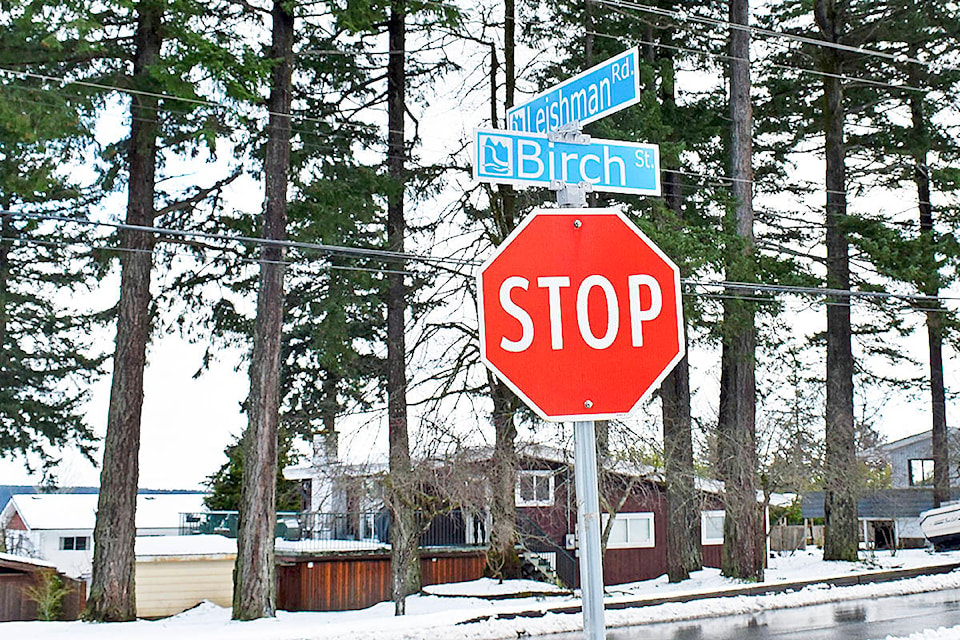Museum at Campbell River Staff
History is all around us, in both metaphorical and physical ways. The more you learn of our local history the more you will notice the little signs of our past that are everywhere.
How a community has been named as it develops says a lot about what it values through time. Naming is a political act. The original names of this place in the Liqwala language are Tlah-mah-tauxw now called Campbell River, Tsa-kwa-luten, now called Cape Mudge, and Quinsam.
It is of note that both Campbell and Mudge were officers who served in early English surveying and mapping expeditions of this region. Neither one spent any real time here. There are countless other geographical features in this region named for men who either never came here, or were just passing through.
What names do you notice in our community today? How have parks, landmarks, streets and businesses been named? In Campbell River a lot of streets were named for the early settlers.
The Thulin family purchased a large pre-emption, most of what is today downtown Campbell River, from the Peacey family in 1904. The name Thulin quickly became synonymous with nearly all the early businesses in what would become Campbell River. They were associated with the first store, hotel, wharf, school, hospital and church.
The Lilelana Pavillion, a favourite gathering spot, was named for the three Thulin daughters, Lillie, Elin and Anna. As the town grew several streets were also named for them, including Thulin Street, Nilhut Street (Thulin spelled backwards), Frederick Crescent and Maria Grove. Glen and Alan Thulin, and Robert and Ron Thulin were the namesakes of Glenalan Road and Robron Road. Lillie Thulin became a successful real estate agent and developer in Campbell River and is responsible for many of these street names. She is also responsible for naming the streets running south to north after tree species in alphabetical order: Alder, Birch, Cedar, Dogwood, Elm, Fir, Greenwood, Hemlock, Ironwood, etc.
Brothers Karl and Anders Marius Petersen, after whom Petersen Road is named, came to Campbell River in 1907 to work in the logging camps. They cut ties and helped to lay the steel for the logging railroad which took the timber to the log dump on the banks of the Campbell River. Later, Anders Marius took up farming in Campbellton.
Lloyd and Bess Leishman bought one-and-a-half acres on Birch Street in the early 1950s when it was known as “the road to the garbage dump.” The Leishmans and Henri Dubeau each gave one half of the land allowance required for the road, which would be named Leishman Road, and they subdivided the land, later building the first pre-school in Campbell River, which Bess operated. Leishman Early Learning and Childcare Centre is still in operation today in its original location on Leishman Road.
As Campbell River has expanded, the streets in the newer subdivisions have been named in other ways. Some streets have been named after local celebrities, such as Ralph Hutton or Rod Brind’Amour. Ralph Hutton, the namesake of Ralph Hutton Drive, began swimming in his hometown of Ocean Falls, and later his family moved to Campbell River. At the age of 18 he was dubbed “The Iron Man” following his medal winning performance at the British Empire Games in Jamaica in 1966. In the same year, he won another six medals at an international swim meet in Vancouver. In 1967 he followed up those successes with six medals at the Pan-Am Games, and was named Canada’s Outstanding Male Swimmer.
Today, we are again seeing place names in the local Liqwala language, such as the recently completed supportive housing development on Dogwood Street, Qwaxsem Place, meaning treehouse, and the Qwalayu House currently under construction. In response to the Truth and Reconciliation calls to action, there are more opportunities for community members to learn Liqwala/Kwak’wala: through School District 72, North Island College, in addition to several community groups and newly developed websites. With increasing recognition of the importance of acknowledging Indigenous territory, seeing the local Indigenous languages represented in our community is an important shift.
What names would you like to see us explore in the future? E-mail erika.anderson@crmuseum.ca with your suggestions!
